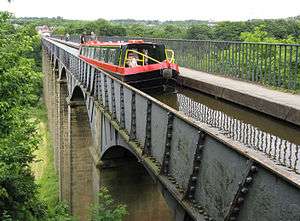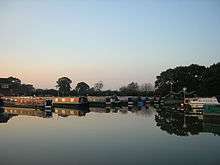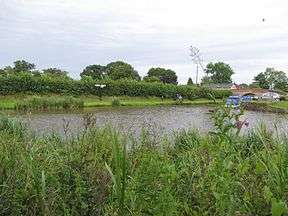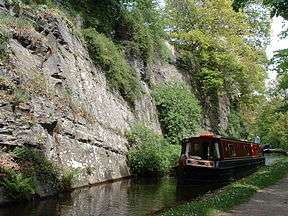Llangollen Canal
| Llangollen Canal | |
|---|---|
|
Llangollen canal: The final narrows before Llangollen | |
| Specifications | |
| Maximum boat length | 70 ft 0 in (21.34 m) |
| Maximum boat beam |
6 ft 10 in (2.08 m) (Fenders must be raised in locks – warning shown at Hurleston) |
| Locks | 21 |
| Maximum height above sea level | 230 ft (70 m) |
| Status | Open |
| Navigation authority | Canal & River Trust |
| Geography | |
| Start point |
Hurleston Junction (Junction with Shropshire Union Canal) |
| End point |
Llangollen (Unnavigable canal continues to Horseshoe Falls) |
| Branch(es) | Montgomery Canal, Prees Branch, Ellesmere Arm, Whitchurch Arm, Trevor Basin |
The Llangollen Canal (Welsh: Camlas Llangollen) is a navigable canal crossing the border between England and Wales. The waterway links Llangollen in Denbighshire, north Wales, with Hurleston in south Cheshire, via the town of Ellesmere, Shropshire. In 2009 an eleven-mile section of the canal from Gledrid Bridge near Rhoswiel through to the Horseshoe Falls, which includes Chirk Aqueduct and Pontcysyllte Aqueduct, was declared a World Heritage site by UNESCO.[1]
The waterway, from which the modern canal takes it name, was built when work to complete the Ellesmere Canal was halted in the early 19th century. The Ellesmere Canal was to be a commercial waterway that linked the Port of Liverpool to the West Midlands. However, due to a variety of problems, such as rising costs and rival competition, the scheme was never finished as intended. As the waterway never reached its proposed main source of water at Moss Valley, Wrexham, a feeder channel was constructed along the side of the Vale of Llangollen to the River Dee; the work created the Horseshoe Falls at Llantysilio.
The Llangollen line became the primary water source from the River Dee for the central section of the incomplete Ellesmere Canal. As such it was not built as a broad-gauge waterway but as a navigable feeder branch. Eventually the Ellesmere Canal became part of the Shropshire Union network in 1846.
In the 1980s, British Waterways took the decision to rename the surviving central sections of the Ellesmere Canal as the Llangollen Canal. As a rebranding of Britain's industrial waterways as leisure destinations, it has encouraged usage and promoted restoration.
History

The grand plan for the Ellesmere Canal was to link the River Mersey with the River Severn. The northward section would begin at Netherpool (now Ellesmere Port) using part of the existing Chester Canal before reaching the River Dee at Chester. The southerly section of the waterway would pass through Overton before heading towards Shrewsbury.
Although work commenced in 1795, the canal was never finished as intended even though major works included two aqueducts at Froncysyllte and Chirk as well a tunnel. Only the southerly section from Lower Frankton to Weston Lullingfields was completed. The final 9 miles (14 km) to Shrewsbury was never started because of financial problems.
Only a short length of the northern section beyond Trevor Basin was built. It was infilled when the canal company decided not to proceed because of rising costs and resistance from property holders to sell their land. The failure to reach the main water source north of Wrexham prompted the creation of the Llangollen feeder from the Horseshoe Falls. The weir, which created the man-made falls on the River Dee, provided water for this part of the network.
Eventually the Ellesmere canal was completed between Frankton Junction to Ellesmere and Whitchurch in Shropshire, eventually reaching the Chester Canal at Hurleston Junction near Nantwich, Cheshire.
The surviving sections of the Ellesmere Canal became part of the Shropshire Union Canal network in 1846.
Decline
Commercial traffic on the canal greatly declined after a waterway breach near Newtown, Powys (now part of the Montgomery Canal) in 1936. By 1939 boat movements on the canal between Hurleston to Llangollen had ceased. The canal was formally closed to navigation under the London Midland and Scottish Railway Company Act of 1944. On 6 September 1945, due to inadequate maintenance, the canal breached its banks east of Llangollen near Sun Bank Halt. The flow of hundreds of tons of water washed away the embankment of the railway further down the hill, tearing a 40 yd crater 50 ft deep.[2] This caused the first traffic of the morning, a mail and goods train composed of 16 carriages and two vans, to crash into the breach, killing one and injuring two engine crew.[3][4]
However, despite its official closure to waterway traffic, the canal was not in-filled or allowed to remain de-watered because it was still required as a water feeder for the Shropshire Union Canal. It also provided a supply of drinking water to a reservoir at Hurleston. In 1955 the Mid & South East Cheshire Water Board agreed to maintain the canal, securing its future.
Restoration
In the latter half of the 20th century canal use by leisure craft grew. The "Llangollen Branch of the Shropshire Union" became popular due to its aqueducts and scenery. The canal was later renamed the Llangollen Canal, becoming one of the most popular canals for holidaymakers in Britain.
A notable feature of the canal is the Pontcysyllte Aqueduct, built by Thomas Telford. Opened in 1805, the aqueduct is more than 300 metres (980 ft) long and 38 metres (125 ft) above the valley floor. It has 19 stone arches, each with a 45-foot (14 metre) span. Another aqueduct carries the canal over the River Ceiriog at Chirk, and there are tunnels nearby at Whitehouses, Chirk, and Ellesmere.
The canal also forms the boundary on two sides of the Fenn's, Whixall and Bettisfield Mosses National Nature Reserve.
 Llangollen canal wharf.
Llangollen canal wharf. A narrowboat traverses the Pontcysyllte Aqueduct.
A narrowboat traverses the Pontcysyllte Aqueduct.
Route
Hurleston to Frankton Junction
Ellesmere Canal Hurleston Branch | ||||||||||||||||||||||||||||||||||||||||||||||||||||||||||||||||||||||||||||||||||||||||||||||||||||||||||||||||||||||||||||||||||||||||||||||||||||||||||||||||||||||||||||||||||||||||||||||||||||||||||||||||||||||||||||||||||||||||||||||||||||||||||||||||||||||||||||||||||||||||||||||||||||||||||||||||||||||||||||||||||||||||||||||||||||||||||||||||||||||||||||||||||||||||||||||||||||||||||||||||||||||||||||||||||||||||||||||||||||||||||||||||||||||||||||||||||||||||||||||||||||||||||||||||||||||||||||||||||||||||||||||||||||||||||||||||||||||||||||||||||||||||||||||||||||||||||||||||||||||||||||||||||||||||||||||||||||||||||||||||||||||||||||
|---|---|---|---|---|---|---|---|---|---|---|---|---|---|---|---|---|---|---|---|---|---|---|---|---|---|---|---|---|---|---|---|---|---|---|---|---|---|---|---|---|---|---|---|---|---|---|---|---|---|---|---|---|---|---|---|---|---|---|---|---|---|---|---|---|---|---|---|---|---|---|---|---|---|---|---|---|---|---|---|---|---|---|---|---|---|---|---|---|---|---|---|---|---|---|---|---|---|---|---|---|---|---|---|---|---|---|---|---|---|---|---|---|---|---|---|---|---|---|---|---|---|---|---|---|---|---|---|---|---|---|---|---|---|---|---|---|---|---|---|---|---|---|---|---|---|---|---|---|---|---|---|---|---|---|---|---|---|---|---|---|---|---|---|---|---|---|---|---|---|---|---|---|---|---|---|---|---|---|---|---|---|---|---|---|---|---|---|---|---|---|---|---|---|---|---|---|---|---|---|---|---|---|---|---|---|---|---|---|---|---|---|---|---|---|---|---|---|---|---|---|---|---|---|---|---|---|---|---|---|---|---|---|---|---|---|---|---|---|---|---|---|---|---|---|---|---|---|---|---|---|---|---|---|---|---|---|---|---|---|---|---|---|---|---|---|---|---|---|---|---|---|---|---|---|---|---|---|---|---|---|---|---|---|---|---|---|---|---|---|---|---|---|---|---|---|---|---|---|---|---|---|---|---|---|---|---|---|---|---|---|---|---|---|---|---|---|---|---|---|---|---|---|---|---|---|---|---|---|---|---|---|---|---|---|---|---|---|---|---|---|---|---|---|---|---|---|---|---|---|---|---|---|---|---|---|---|---|---|---|---|---|---|---|---|---|---|---|---|---|---|---|---|---|---|---|---|---|---|---|---|---|---|---|---|---|---|---|---|---|---|---|---|---|---|---|---|---|---|---|---|---|---|---|---|---|---|---|---|---|---|---|---|---|---|---|---|---|---|---|---|---|---|---|---|---|---|---|---|---|---|---|---|---|---|---|---|---|---|---|---|---|---|---|---|---|---|---|---|---|---|---|---|---|---|---|---|---|---|---|---|---|---|---|---|---|---|---|---|---|---|---|---|---|---|---|---|---|---|---|---|---|---|---|---|---|---|---|---|---|---|---|---|---|---|---|---|---|---|---|---|---|---|---|---|---|---|---|---|---|---|---|---|---|---|---|---|---|---|---|---|---|---|---|---|---|---|---|---|---|---|---|---|---|---|---|---|---|---|---|---|---|---|---|---|---|---|---|---|---|---|---|---|---|---|---|---|---|---|---|---|---|---|---|---|---|---|---|---|---|---|---|---|---|---|---|---|---|---|---|---|---|---|---|---|---|---|---|---|---|---|---|---|---|---|---|---|---|---|---|---|---|---|---|---|---|---|---|---|---|---|---|---|---|---|---|---|---|---|---|---|---|---|---|---|---|---|---|---|---|---|---|---|---|---|---|---|---|---|---|---|---|---|---|---|---|---|---|---|---|---|---|---|
Legend
| ||||||||||||||||||||||||||||||||||||||||||||||||||||||||||||||||||||||||||||||||||||||||||||||||||||||||||||||||||||||||||||||||||||||||||||||||||||||||||||||||||||||||||||||||||||||||||||||||||||||||||||||||||||||||||||||||||||||||||||||||||||||||||||||||||||||||||||||||||||||||||||||||||||||||||||||||||||||||||||||||||||||||||||||||||||||||||||||||||||||||||||||||||||||||||||||||||||||||||||||||||||||||||||||||||||||||||||||||||||||||||||||||||||||||||||||||||||||||||||||||||||||||||||||||||||||||||||||||||||||||||||||||||||||||||||||||||||||||||||||||||||||||||||||||||||||||||||||||||||||||||||||||||||||||||||||||||||||||||||||||||||||||||||
The canal at Hurleston Junction rises from the Shropshire Union Canal main line, through four adjacent locks.
Wrenbury lift bridge is operated by use of a British Waterways key, and involves closing barriers and stopping traffic on a sometimes-busy road.
At Grindley Brook the canal passes through three locks and a three-chamber staircase lock, attended during summer months by a lock keeper.
At Whitchurch a short arm of the canal remains open. Originally this continued almost to the centre of the town, though sections have since been built over. Whitchurch Waterway Trust promotes the restoration of this arm.
Between bridges 44 and 47 the canal passes through Whixall Moss.
Adjacent to bridge 46 is Whixall Moss Junction leading to the Prees Branch (see below).
Between bridges 54 and 57 the canal passes the Ellesmere meres.
At Ellesmere there is a short arm towards the town.
The canal also passes though Burland, Quoisley Bridge, and Bettisfield.
Prees Branch
Prees Branch | ||||||||||||||||||||||||||||||||||||||||||||||||||||||||||||||||
|---|---|---|---|---|---|---|---|---|---|---|---|---|---|---|---|---|---|---|---|---|---|---|---|---|---|---|---|---|---|---|---|---|---|---|---|---|---|---|---|---|---|---|---|---|---|---|---|---|---|---|---|---|---|---|---|---|---|---|---|---|---|---|---|---|
Legend
| ||||||||||||||||||||||||||||||||||||||||||||||||||||||||||||||||
The Prees Arm of the canal was originally intended to reach Prees, but was only constructed as far as Quina Brook. Today it is only open for 7 furlongs (1.5 km), with two lift bridges, to a marina at the end of the navigable part; beyond that, the remainder of the constructed canal now forms the Prees Branch Canal Nature Reserve. The first bridge (Allman's Bridge) was one of the last manual lift bridges to be converted to hydraulic operation in 2010. Dobson's Bridge, a fixed humpback bridge, was classified in 1987 as a Grade Il listed building.[5]
 Old map showing the complete branch to Quina Brook
Old map showing the complete branch to Quina Brook Evening over Whixall Marina
Evening over Whixall Marina
Frankton Junction to Trevor Basin
Frankton Junction to Trevor Basin | |||||||||||||||||||||||||||||||||||||||||||||||||||||||||||||||||||||||||||||||||||||||||||||||||||||||||||||||||||||||||||||||||||||||||||||||||||||||||||||||||||||||||||||||||||||||||||||||||||||||||||||||||||||||||
|---|---|---|---|---|---|---|---|---|---|---|---|---|---|---|---|---|---|---|---|---|---|---|---|---|---|---|---|---|---|---|---|---|---|---|---|---|---|---|---|---|---|---|---|---|---|---|---|---|---|---|---|---|---|---|---|---|---|---|---|---|---|---|---|---|---|---|---|---|---|---|---|---|---|---|---|---|---|---|---|---|---|---|---|---|---|---|---|---|---|---|---|---|---|---|---|---|---|---|---|---|---|---|---|---|---|---|---|---|---|---|---|---|---|---|---|---|---|---|---|---|---|---|---|---|---|---|---|---|---|---|---|---|---|---|---|---|---|---|---|---|---|---|---|---|---|---|---|---|---|---|---|---|---|---|---|---|---|---|---|---|---|---|---|---|---|---|---|---|---|---|---|---|---|---|---|---|---|---|---|---|---|---|---|---|---|---|---|---|---|---|---|---|---|---|---|---|---|---|---|---|---|---|---|---|---|---|---|---|---|---|---|---|---|---|---|---|---|
Legend
| |||||||||||||||||||||||||||||||||||||||||||||||||||||||||||||||||||||||||||||||||||||||||||||||||||||||||||||||||||||||||||||||||||||||||||||||||||||||||||||||||||||||||||||||||||||||||||||||||||||||||||||||||||||||||
At Frankton Junction the Montgomery Canal, which is partially restored, heads southwards. For historic reasons the bridge numbering continues down the Montgomery Canal and a second bridge numbering series for the Llangollen Canal begins with Rowson's Bridge (which is numbered both 1W and 70). The "W" addition is a recent act by British Waterways, to avoid possible confusion, especially for emergency services, of having different bridges on the same canal with the same number.
The Llangollen Canal passes through Hindford, Saint Martin's, Preesgweene, Chirk Bank, Chirk and Froncysyllte, and includes the Chirk Aqueduct, the Chirk Tunnel and the Pontcysyllte Aqueduct.

 New Marton Bottom Lock
New Marton Bottom Lock New Marton Top Lock
New Marton Top Lock

Trevor Basin to Horseshoe Falls
Trevor Basin to Horseshoe Falls | |||||||||||||||||||||||||||||||||||||||||||||||||||||||||||||||||||||||||||||||||||||||||||||||||||||||||||||||||||||||||||||||||||
|---|---|---|---|---|---|---|---|---|---|---|---|---|---|---|---|---|---|---|---|---|---|---|---|---|---|---|---|---|---|---|---|---|---|---|---|---|---|---|---|---|---|---|---|---|---|---|---|---|---|---|---|---|---|---|---|---|---|---|---|---|---|---|---|---|---|---|---|---|---|---|---|---|---|---|---|---|---|---|---|---|---|---|---|---|---|---|---|---|---|---|---|---|---|---|---|---|---|---|---|---|---|---|---|---|---|---|---|---|---|---|---|---|---|---|---|---|---|---|---|---|---|---|---|---|---|---|---|---|---|---|---|
Legend
| |||||||||||||||||||||||||||||||||||||||||||||||||||||||||||||||||||||||||||||||||||||||||||||||||||||||||||||||||||||||||||||||||||
This section was built as a navigable feeder and is both shallow and narrow. Some sections near Llangollen are too narrow for boats to pass each other and it is necessary to scout ahead to check for oncoming boats.
Navigation by powered craft is prohibited beyond the entrance to Llangollen Marina and the final section is used only by the horse drawn trip boats. British Waterways maintains a gravel shoal immediately upstream of the marina entrance past Llangollen Wharf. This maintains a draught which most narrowboats cannot pass, but which is passable by the shallow draughted trip boats.
In 2005, a marina was constructed by British Waterways, just upstream from Llangollen Wharf, to relieve the acute shortage of casual moorings. A charge is made for all moorings over 48 hours at Llangollen. About 100 yards downstream of the wharf there are about a dozen 'visitor' moorings complete with individual electricity and water at each. There are none at the marina itself.
See also
References
- ↑ "Unesco names Pontcysyllte aqueduct as UK's latest World Heritage site". The Times. London. 28 June 2009. Retrieved 12 January 2010.
- ↑ Hugh McKnight (1987). The Shell Book of Inland Waterways. David & Charles. p. 28. ISBN 0-7153-8239-X.
- ↑ Archived 1 January 2007 at the Wayback Machine.
- ↑ "BBC News – North East Wales". Bbc.co.uk. 1 January 1970. Retrieved 29 May 2013.
- ↑ http://www.britishlistedbuildings.co.uk/en-428422-shropshire-union-canal-edstaston-branch-
- Denton, John Horsley (1984). Montgomershire Canal and the Llanymynech Branch of the Ellesmere Canal. Lapal Publications. ISBN 0-9509238-1-8.
- Waterways World (2005). Canal Guide 2 – Llangollen and Montgomery Canals. Waterways World Ltd. ISBN 1-870002-89-X.
External links
| Wikimedia Commons has media related to Llangollen Canal. |
- Llangollen Canal – North Wales Borderlands website
Coordinates: 52°58′20″N 3°10′16″W / 52.9722°N 3.1711°W
